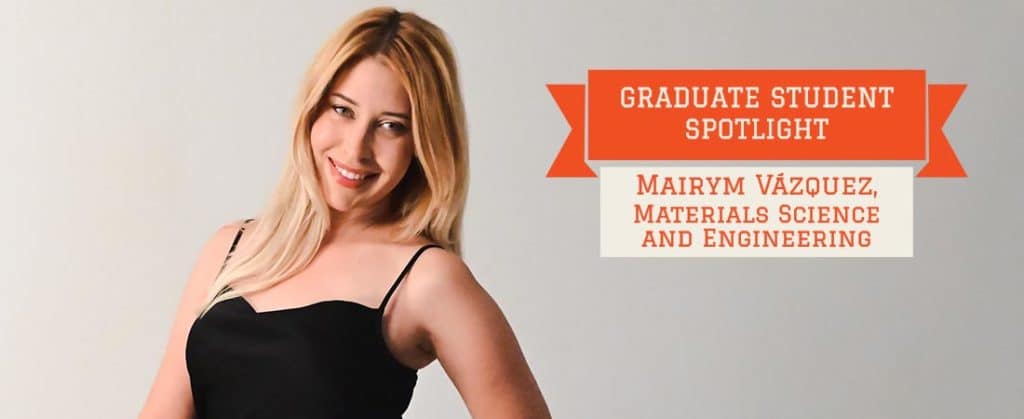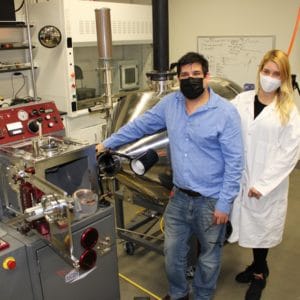In 2017, Hurricane Maria devastated much of the Caribbean, including Puerto Rico, leaving many areas without power and other utilities for months. With some of the advanced materials characterization equipment disabled, Mairym Vázquez, then a graduate student at the University of Puerto Rico at Mayagüez (UPRM), needed to find an alternate location for her materials science research.
“My mentor at the University of Puerto Rico had a working relationship with Dr. Orlando Rios at the Oak Ridge National Laboratory (ORNL), they were sending materials for our research, but we wanted to do more advance characterization to the material.” Vázquez explained. “I already had funding for a summer research project, so I needed a place to sponsor me. My mentor talked to Dr. Rios and they said that they were glad to have me that summer.”
That summer research eventually grew into a more long-term commitment.
“Originally, I came here just for the summer so I could finish my research, but Dr. Rios offered me a position at ORNL if I wanted to stay, so I stayed,” Vázquez said.
Now a doctoral student in the Department of Materials Science and Engineering, Vázquez currently works characterizing metal alloys, especially aluminum-cerium alloys. Cerium is one of seventeen minerals known as rare earth elements. These elements possess unique physical and chemical properties that have made them essential in the manufacture of technological equipment such as magnets, chemical catalysts, and batteries.
These same properties, however, make them difficult to mine and process and are scarce in the market. Currently, cerium is considered a by-product of the rare earth mining industry. There are only some small applications for the element, such as creating the spark in cigarette lighters and as a catalyst in self-cleaning ovens.
“If we find a bulk application for cerium, it will benefit the whole rare earth industry. Now they won’t have this by-product, and the cost of processing rare earth will go down. Not only will the processing cost go down, but now there will be an additional revenue stream through the sale of cerium” Vázquez noted.
Like most alloys, combining cerium and aluminum creates a material that has properties that are superior to the pure elements, such as increased strength and corrosion resistance.
“Cerium will burst into flames by itself, but when we alloy it with aluminum, it becomes extremely stable. Aluminum reacts with oxygen very quickly and becomes oxidized. When mixed with cerium, however, the resulting material doesn’t react with oxygen, so it doesn’t corrode,” Vázquez elaborated.
Aluminum is very lightweight but lacks the strength to be used in some applications. The addition of cerium, however, greatly expands its potential uses.
“Automotive and aerospace applications are always looking for a strong, but lightweight, material that can work in high-temperature applications, so that’s one of the things we are researching. And the applications are endless because aluminum is everywhere from computer chips all the way up to the space shuttle” Vázquez revealed.
As an undergraduate student, Vázquez obtained a bachelor’s degree in industrial engineering. A required materials science class while pursing the degree, altered the course of her graduate studies.
“I had no idea that you could study material science. I had been focused on industrial engineering,” Vázquez explained. “The first time I took a materials class, we mixed concrete to form a cylinder. After letting it cure for a week, we performed a compression test to break it. That was when I knew I wanted to pursue materials science.”
Having discovered the field of materials science, she plans to continue this research in the future, possibly operating her own testing lab. Vázquez feels that materials research can positively impact the world around us by developing materials for use in alternative energy technologies and reducing carbon dioxide emissions. Dr. Rios is also adjunct professor at UPRM and Vázquez is very excited about continuing her research and finding additional collaborations between UT and UPRM.
“Materials is everything,” Vázquez exclaimed. “As a materials scientist and engineer we can develop new, more functional, materials for all kinds of applications that can improve the technologies we use and make our lives better.”

